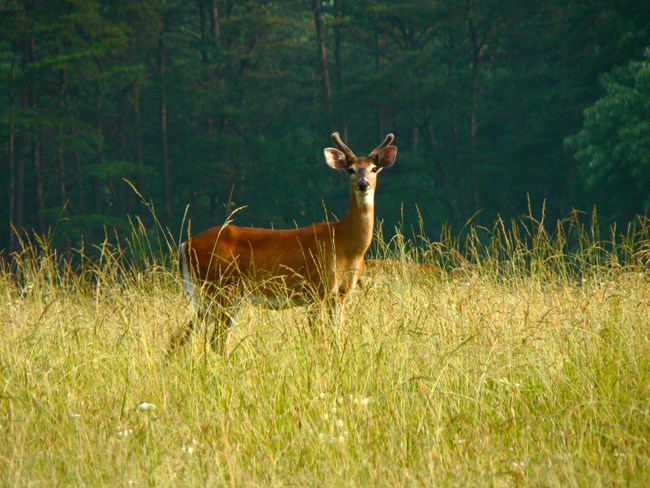
NPS Photo/Manassas NBP Are there too many deer?Deer herds throughout the eastern United States were heavily hunted after the arrival of Europeans around 1600. In the early 1900s, deer populations began to increase due to a lack of predators and increased availability of food and habitat. Today, Manassas National Battlefield Park has an overabundant population of white-tailed deer. Long-term monitoring of white-tailed deer populations and their effect on park plant communities indicate that at current densities, the park’s forest cannot sustain itself. Damage by dense deer populations is widespread and documented across ecological systems, wildlife and plant communities, and adversely impacts the park’s historic landscapes. Deer Management at Manassas National Battlefield ParkThe National Park Service balances the needs of wildlife and plants in Manassas National Battlefield Park, while also maintaining the park’s historic landscape. Research has shown that vegetation damage occurs when deer populations exceed 20 per square mile. Reducing the deer population is needed to allow regeneration in a healthy, diverse forest that supports native vegetation and wildlife, including deer. The National Park Service uses an adaptive management approach that is flexible based on how deer and vegetation populations respond. Without continued management, deer populations would quickly rebound and eat nearly all tree seedlings and other plants before they could grow. Scientists will monitor the response of park vegetation to fewer deer in order to inform future deer management practices. During Deer ManagementExtensive safety measures will be in place during operations, which will take place at night when the park is closed. Highly trained firearms experts experienced in conducting wildlife reduction operations will work under the direction of National Park Service (NPS) natural resource management specialists and in coordination with park law enforcement rangers to conduct reduction actions safely and effectively. 
NPS Photo/Manassas NBP Extensive safety measures will be in place during operations, which will take place at night when the park is closed. Highly trained firearms experts experienced in conducting wildlife reduction operations will work under the direction of National Park Service (NPS) natural resource management specialists and in coordination with park law enforcement rangers to conduct reduction actions safely and effectively. Frequently Asked Questions The National Park Service (NPS) developed a Deer Management Plan/Environmental Impact Statement (plan/EIS) to provide an effective deer management strategy that supports long-term protection, preservation, and restoration of native vegetation, wildlife and other natural and cultural resources in the battlefield.
Yes, venison will be donated to local food banks and other organizations, consistent with NPS public health guidelines.
Research has shown that vegetation damage occurs when deer populations exceed 20 per square mile. Park service staff will continue to monitor and assess the park’s vegetation as deer management progresses. Until sustainable forest regeneration is occurring within the park, we will continue to manage deer populations.
The park participates in a CWD monitoring program. In 2025 for the first time, the park received positive CWD test results for 2 animals in the park. All venison from deer testing positive for CWD is destroyed.
No. Public hunting at Manassas National Battlefield Park is not authorized in the park’s legislation.
Yes. The management plan is designed to bring the deer population to a level that allows the park’s forests to regenerate. White-tailed deer are part of the ecosystem, and future generations of park visitors will continue to have the opportunity to see deer in the park.
Several parks in the Virginia, Maryland, and DC region are implementing white-tailed deer management plans: Antietam National Battlefield, Catoctin Mountain Park, Chesapeake & Ohio Canal National Historical Park, Harpers Ferry National Historical Park, Monocacy National Battlefield, National Capital Parks - East, and Rock Creek Park. Catoctin has actively worked to reduce deer populations since 2010 and has seen dramatic increases in tree seedling density.
National Park Service areas in other regions are actively performing deer management including Gettysburg National Military Park, Indiana Dunes National Lakeshore, Fire Island National Seashore, Valley Forge National Historical Park, and Cuyahoga Valley National Park. Please email us with any questions or concerns.
|
Last updated: April 9, 2025
